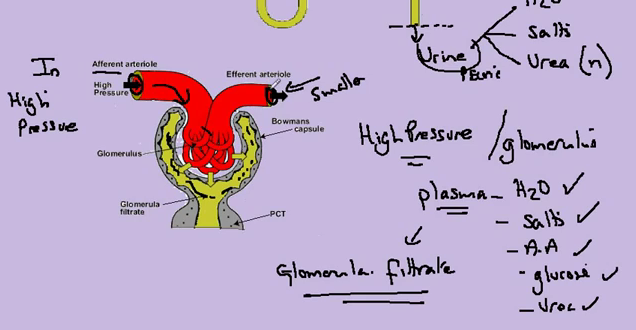Describe the structure of a Nephron to include Bowman's Capsule and glomerulus, convoluted tubules, loop of Henlé and collecting duct.
Renal Vein
.Carries blood away from the kidney and back to the right hand side of the heart. Blood in the kidney has had all its urea removed. (Urea is produced by your liver to get rid of excess amino-acids).
Blood in the renal vein also has exactly the right amount of water and salts. This is because the kidney gets rid of excess water and salts. The kidney is controlled by the brain. A hormone in our blood called ADH is used to control exactly how much water is excreted.
Renal Artery
This blood vessel supplies blood to the kidney from the left hand side of the heart. This blood must contain glucose and oxygen. Blood in the renal artery must have pressure to be able to filter the blood.
Blood supplied to the kidney contains a toxic product called urea which must be removed from the blood. It may have too much salt and too much water. (The kidney removes these excess materials)
Pelvis
This is the region of the kidney where urine collects.
Ureter
The ureter carries the urine down to the bladder and is stored there until excreted.
E. Medulla
The medulla is the inside part of the kidney (green) (real life: dark red) This is where the amount of salt and water in your urine is controlled. It consists of billions of loops of Henlé. ADH makes the loops work harder to pump more sodium ions. The result of this is that very concentrated urine is produced.
Cortex
The cortex is the outer part of the kidney. This is where blood is filtered. We call this process "ultra-filtration" because it only works if the blood entering the kidney in the renal artery is at high pressure.
A glomerulus is a tiny ball of capillaries (found in the cortex). Each glomerulus is surrounded by a "Bowman's Capsule". Glomeruli leak. Things like red blood cells, white blood cells, and platelets stay in the blood vessels. Most of the plasma leaks out into the Bowman's capsules.
Most of this liquid, which we call "ultra-filtrate" is re-absorbed in the medulla and put back into the blood.
 28a Enzymes
28a Enzymes


















